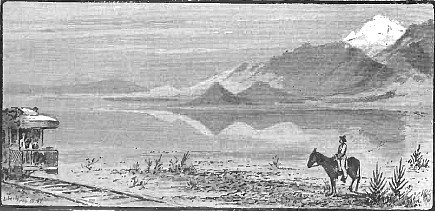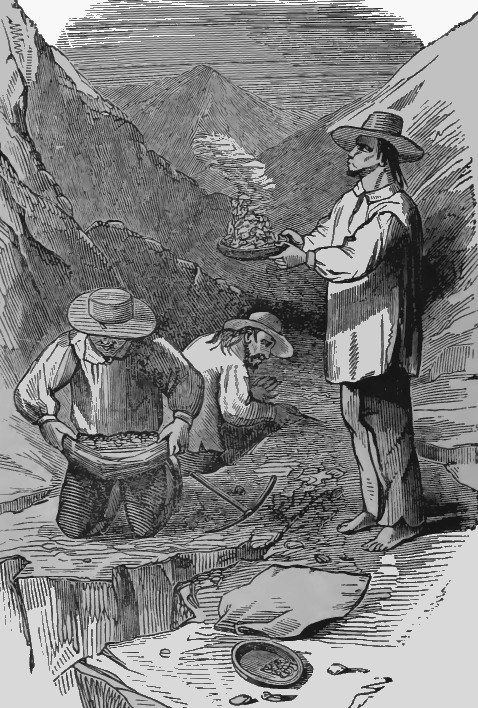The world's progress has always been marked by a plenitude of gold and silver. There is little doubt but that the glory of Solomon's reign was created by the discovery of the gold of Ophir. The civilization of Greece and Rome was promoted by the working of the mines of Europe and Asia for precious metals. The civilization of the world relapsed into barbarism during the Middle Ages, but was revived by the discovery of the wealth of the Incas and the Aztecs. ' The great gold rush to the gold fields of California gave new impetus to the wheels of industry in all directions, and, in our day, the highest stage of civilization of the Twentieth Century has been promoted to a great extent through the plenitude of native gold and silver as a circulating medium. In 1863 the placer mines of California were exhausted, but through vein mining and hydraulic mining, the output of gold for that State amounted to about twenty-five millions of dollars per annum. The discovery of the Comstock Lode in 1859, and of silver ore in other portions of Nevada and in Utah, was sufficient to direct the attention of prospectors to the possibilities of rich mines in Arizona and New Mexico. To this fact can be attributed the addition of many thousand energetic and adventurous men.
The news of the discovery of placers in Apacheria created great gold rush to New Mexico. Captain Pishon, with Bob Groom as pilot, following the old Beale Wagon Trail along the 35th parallel, made his way into the Valley, where he established a temporary camp. From there he discovered the Walker Party on Lynx Creek and other creeks around Prescott, and from the report which he gave to General Carleton, the great expectations which had been built up in Carleton 's mind, seemed to be on the point of realization. It will be remembered that this was only about fifteen years after the discovery of the rich gold placers of California, and, at this date, 1863, mining was the business in California, Nevada and Utah. The rich discoveries of gold and silver in the two latter territories were published throughout the world and caused a typical gold rush. The Government, at that time, needed the precious metals to finance its military operations. The bonds of the Government, while the principal was payable in currency, bore interest which was payable in gold. This interest ranged from six to seven and a half per cent per annum, and at this time, which was just before the battle of Gettysburg, gold reached its high-water mark in New York, selling at about 280 premium, so everyone can sympathize with General Carleton when, from reports, he supposed that the gold fields of Arizona would equal, if not surpass, the placers of California.
Upon their return, Captain Pishon and General Clark, the Surveyor-General, after spending two weeks in the mines, reported them of extraordinary value. Men, they said, were making from ten to a hundred dollars a day with a rocker. In and around Weaver, fortunes had been picked up in large nuggets, and it was supposed that the placer fields had been only touched and were a great deal more extensive than they afterwards proved to be. In the meantime expeditions had been organized by private citizens to go to the new El Dorado. The first is that mentioned by Col. Banta: "Much has been written about the 'Captain Joe Walker' party; its aims and objects, etc One 'authentic' account says it was a prospecting expedition headed for the canyon of the Little Colorado river, where Walker had found gold in the early forties; all these stories are erroneous and far from the truth. "Captain Joseph Walker was an honorable man, and a natural commander of man. Captain Sibley, of the Southern Confederacy, had undertaken the conquest of New Mexico, and the capture of Fort Union, the great depot of supplies of the, U. S. Government. However, the defeat of the Sibley expedition at Apache Canyon, changed the aspect of affairs. "Captain Joe Walker, with a few followers, started eastward from California, gathering new members en route, until he reached Colorado. He had no intention of going to Arizona when he left California; otherwise he would have gone south from California and entered Arizona either at La Paz or Yuma, and certainly would not have gone eastward through several states and territories if Arizona had been his objective point of destination. Captain Walker and all his followers—with one exception—were Southern sympathizers. The defeat of General Sibley at Apache Canyon was an unexpected event, which Walker had not thought possible, and Sibley's complete evacuation of New Mexico left that Territory in the hands of the Union troops. This changed the aspect of affairs, and the Walker party metamorphosed into a 'prospecting party.' At this time New Mexico was under martial law, and naturally all armed parties were viewed with suspicion, hence the 'prospecting party.' There was one man with the Walker party of Union sympathies, named A. C. Benedict, who informed General James H. Carleton, the Union Commander in Santa Fe, of the purpose of the Walker Expedition.
Captain Walker, feeling that his movements were under military surveillance, decided to make a strategic movement and hoped by the ruse to deceive the U. S. military. Instead of going down the Rio Grande, he struck westward from Albuquerque over the old immigrant trail leading from that place to Los Angeles. Having reached Antelope Springs at the base of the San Francisco mountains, and the present site of Flagstaff, Walker knew he must be north of the Gila river, and a southward course would lead to that stream. In those early days greenbacks were at a discount. The gold standard prevailed. Bacon was a dollar and a half a pound in gold, or three dollars in paper money, and the same price for coffee and sugar. A pair of the most ordinary boots cost $25 in gold. At this rate I bought no boots, but made moccasins. The winter of 1864-65 found me in Prescott. "During the summer a party of hardy prospectors and mountaineers from Colorado and California, under the lead of a noted trapper, named Captain Joe Walker, had pushed forward into the country around where the city of Prescott now stands, and had discovered rich gold placers. This new discovery had created a gold rush excitement, and all that prevented a general stampede thereto was the difficulty of getting there, there being three or four hundred miles of travel through the hostile Indian country to reach that locality.
"It was during the early part of this year that Congress had passed the act organizing the territory of Arizona and at the time of which I write the territorial officials had been appointed and were on their way out from Washington to their posts of duty. Governor John N. Goodwin, the head of the delegation, had decided to locate the capital of the new territory in the vicinity of the new native gold discovery made by the Walker party. Arizona's reputation for mineral wealth is well established. So high an authority as Baron Von Humboldt, himself, predicted that the wealth of the world would yet be found in this region. And was not the largest native silver nugget ever taken from the earth brought to light in Arizona? It weighed 2,700 pounds. Unfortunately for the Spanish adventurers who found it, it was so very large that his wise and canny majesty of Spain declared it a "curiosity," and so, by the terms of the charter, took it himself. Silver is as plentiful to-day in Arizona as it was then, being unearthed in its pure state and in combination with many base metals. In both conditions it has provided more queer and beautiful cabinet specimens than any other country. That the present low price of silver does not make it profitable to work some of these argentiferous mines, is another matter.
As for gold, that is always valuable, and, while it is not as plentiful as silver, it has been revealed in great quantities, both in its free state and in its matrix of quartz, and in combination with sulfur, lead, antimony, copper ore and other minerals. It is not so long ago that the discoverers of the placer deposits of Antelope Peak took one-half million of dollars in gold from less than one acre of ground, while the quartz mines are paying more steadily, if not so royally. Copper of a very high grade is found in large amounts in Arizona. The total output of these three metals during the last seventeen years amounts to $95,000,000. In fact the whole country is a vast mineral treasure house, veined with gold, silver, copper, iron, lead and almost every other metal. From the geological formation of Arizona and a part of New Mexico, it would appear that some volcanic upheaval had thrown all the minerals together in a heap, for they do not follow the usual well-established methods of such deposits in other States and Territories, and until you strike your pick in the ground you scarcely know what kind of a mine you are going to have. Mining discoveries and developments during 1898 increased values more than twenty millions of dollars the beginning only of a richer future.
Return
to The Arizona Page:
Arizona Gold Rush Mining History



